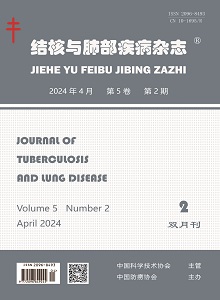-
Analysis of knowledge, attitude and behavior on tuberculosis control and prevention among 454 primary and secondary school students in Panyu district of Guangzhou
- GUO Wan-ru,TAN Shou-yong, LAO Luo-bin, HE Chao-wen,LIN Hui, LAI Jing-wen.
-
Journal of Tuberculosis and Lung Health. 2014, 3(2):
104-109.
doi:10.3969/j.issn.2095-3755.2014.02.007
-
 Abstract
(
299 )
Abstract
(
299 )
 PDF (826KB)
(
239
)
PDF (826KB)
(
239
)
 Save
Save
-
References |
Related Articles |
Metrics
Objective To understand the situation of knowledge, attitude and behavior on tuberculosis (TB) control and prevention among students from a primary school and a middle school in Shiqi Town of Panyu District, Guangzhou City, and to provide direction and focus for health education of TB.Methods An investigation was conducted in a primary school and a middle school of Panyu District on 10-15 May 2013. Four hundred and sixty-four students were recruited through cluster sampling. Face-to-face interview with a standard questionnaire was carried out in participants and the following information were collected: the basic information of the students, the awareness of 5 TB core information, attitude and behavior on TB, the method to obtain TB knowledge, as well as what knowledge related to TB are needed. In the end, the number of valid questionnaires was 454, so the rate of effective response was 97.84% (454/464), including 230 junior middle school students in grade 2 and 224 primary school students in grade 5. The FoxPro software was used for the establishment of the database and the statistics analysis; the χ2 test was used to analyze the difference between the groups.Results The overall awareness rate of 5 TB core information was 70.44% (1599/2270), and it was 79.22% (911/1150) and 61.43% (688/1120) respectively among the junior middle school and primary school students; it was 68.08% (674/990) and 72.27% (925/1280) respectively among the male and female. The rates of students who had active attitude towards knowing more about TB, who showed concern about whether the classmate gets TB or not, who were willing to take actions on TB prevention were 33.04% (74/224), 23.21% (52/224) and 60.71% (136/224) respectively among the primary school students; the rates were 46.09% (106/230), 50.43% (116/230) and 98.26% (226/230) respectively among the junior middle school students. The rates of correct answers to questions about no spitting, ventilation by opening windows, strengthening physical exercise, health-seeking behavior were respectively 77.68% (174/224), 69.64% (156/224), 67.86% (152/224) and 54.46% (122/224) in the primary school students; those rates were 96.52% (222/230), 94.78% (218/230), 89.57% (206/230) and 86.96% (200/230) respectively in the junior middle school students. The top 3 methods for the primary school students to acquire information/knowledge were from newspapers and magazines 60.71% (136/224), school courses 58.93% (132/224) and TV 58.04% (130/224); for the junior middle school students, the top 3 methods were from TV 87.83% (202/230), newspapers and magazines 77.39% (178/230), internet and broadcast 73.91% (170/230). The rates of students who would like to obtain the knowledge about TB prevention, treatment, rehabilitation and others were 83.04% (186/224), 58.93% (132/224), 58.93% (132/224) and 3.57% (8/224) in the primary school students; the rates were 97.39% (224/230), 90.43% (208/230), 88.70% (204/230) and 11.30% (26/230) in the junior middle school students.Conclusion The students in junior middle school and primary school of Panyu District had lower awareness of the core information and correct behaviors on TB prevention and control; the knowledge acquisition approach of the students was inadequate; the students were lack of motivation and positive attitude towards obtaining TB knowledge. According to the different needs of the students at different school levels, the TB institutions should carry out school health promotion activities in more effective ways to improve the TB knowledge level of students.

 Wechat
Wechat